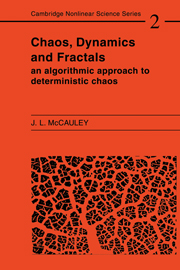Book contents
- Frontmatter
- Dedication
- Contents
- Preface
- Miscellaneous Frontmatter
- Introduction
- 1 Flows in phase space
- 2 Introduction to deterministic chaos
- 3 Conservative dynamical systems
- 4 Fractals and fragmentation in phase space
- 5 The way to chaos by instability of quasiperiodic orbits
- 6 The way to chaos by period doubling
- 7 Introduction to multifractals
- 8 Statistical mechanics on symbol sequences
- 9 Universal chaotic dynamics
- 10 Intermittence in fluid turbulence
- 11 From flows to automata: chaotic systems as completely deterministic machines
- Bibliography
- Index
6 - The way to chaos by period doubling
Published online by Cambridge University Press: 05 October 2013
- Frontmatter
- Dedication
- Contents
- Preface
- Miscellaneous Frontmatter
- Introduction
- 1 Flows in phase space
- 2 Introduction to deterministic chaos
- 3 Conservative dynamical systems
- 4 Fractals and fragmentation in phase space
- 5 The way to chaos by instability of quasiperiodic orbits
- 6 The way to chaos by period doubling
- 7 Introduction to multifractals
- 8 Statistical mechanics on symbol sequences
- 9 Universal chaotic dynamics
- 10 Intermittence in fluid turbulence
- 11 From flows to automata: chaotic systems as completely deterministic machines
- Bibliography
- Index
Summary
Universality at transitions to chaos
We use the word ‘universal’ in the sense of ‘including, pertaining to, affecting all members of a class or group’. The important idea is therefore that of a ‘universality class’ and it is necessary to have a criterion for membership.
The modern use of these phrases in physics stems from the renormalization group theory of phase transitions in classical statistical mechanics, where all models with the same symmetry and dimension yield the same critical exponents independently of other details of the Hamiltonian, so long as corrections to scaling are ignored. The predictions of Lorenz and Ruelle and Takens had been made, but had generated no large following; just as broken symmetries dominated the physics of the 1960s, the 1970s were the heyday of critical phenomena and Wilson's renormalization group method. So, when Feigenbaum (1978, 1980) argued near the end of that decade that the ‘period-doubling’ transition to chaos yields universal critical exponents, many physicists became excited to learn what was meant by ‘deterministic chaos’ and then had to learn about the ‘strange’ mathematical objects called Cantor sets, because the period-doubling limit defines a particular Cantor set.
Feigenbaum developed his renormalization group theory of period doubling by starting with an iterative map of the interval, the logistic map x → f(x,D) = Dx(l – x). He showed that all smooth maps of the interval with a quadratic maximum (Fig. 6.1) should yield the same critical exponents, so that the order of the maximum is one factor that determines the universality class.
Information
- Type
- Chapter
- Information
- Chaos, Dynamics, and FractalsAn Algorithmic Approach to Deterministic Chaos, pp. 173 - 185Publisher: Cambridge University PressPrint publication year: 1993
